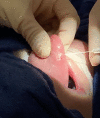Treatment of tongue telangiectasia in a patient with hereditary haemorrhagic telangiectasia
- PMID: 33139375
- PMCID: PMC7607586
- DOI: 10.1136/bcr-2020-238485
Treatment of tongue telangiectasia in a patient with hereditary haemorrhagic telangiectasia
Abstract
A 61-year-old Caucasian woman presented to an outpatient otolaryngology clinic with increased bleeding from a dorsal tongue telangiectasia for 3 weeks. Her history was significant for hereditary haemorrhagic telangiectasia (HHT), a rare condition that causes vascular dysplasia, and recent symptomatic anaemia requiring blood transfusions. After failing medical management with topical haemostatic agents, she was offered and underwent surgical intervention to remove the tongue telangiectasia with duel therapy potassium titanyl phosphate (KTP) laser coblation and bevacizumab injections. A team of otolaryngologists removed the lesion without complications, and the patient denied bleeding, had minimal pain, and endorsed increased quality of life postoperatively. Tongue telangiectasias can cause life-threatening bleeding in some patients with HHT, and no surgical management guidelines exist to treat them. This case demonstrates the efficacy of KTP laser followed by bevacizumab injections in treating tongue telangiectasias in a patient with HHT.
Keywords: ear; head and neck surgery; nose and throat; nose and throat/otolaryngology; otolaryngology / ENT; therapeutic indications.
© BMJ Publishing Group Limited 2020. No commercial re-use. See rights and permissions. Published by BMJ.
Conflict of interest statement
Competing interests: None declared.
Figures
Similar articles
-
Comparison of electrosurgical plasma coagulation and potassium-titanyl-phosphate laser photocoagulation for treatment of hereditary hemorrhagic telangiectasia-related epistaxis.Int Forum Allergy Rhinol. 2014 Aug;4(8):640-5. doi: 10.1002/alr.21328. Epub 2014 Apr 9. Int Forum Allergy Rhinol. 2014. PMID: 24719397 Clinical Trial.
-
In-Office KTP Laser for Treating Hereditary Hemorrhagic Telangiectasia-Associated Epistaxis.Laryngoscope. 2021 Mar;131(3):E689-E693. doi: 10.1002/lary.28824. Epub 2020 Jun 18. Laryngoscope. 2021. PMID: 32557619
-
Endoscopic-guided coblation treatment of nasal telangiectasias in hereditary hemorrhagic telangiectasia: "How I do it".Am J Rhinol Allergy. 2017 May 1;31(3):205-206. doi: 10.2500/ajra.2017.31.4427. Am J Rhinol Allergy. 2017. PMID: 28490409
-
Nd:YAG Laser Treatment for Extranasal Telangiectasias: A Retrospective Analysis of 38 Patients with Hereditary Hemorrhagic Telangiectasia and Review of the Literature.ORL J Otorhinolaryngol Relat Spec. 2016;78(5):245-251. doi: 10.1159/000447949. Epub 2016 Aug 4. ORL J Otorhinolaryngol Relat Spec. 2016. PMID: 27486666 Review.
-
Hereditary haemorrhagic telangiectasia: a cause of preventable morbidity and mortality.Ir J Med Sci. 2009 Jun;178(2):135-46. doi: 10.1007/s11845-008-0220-5. Epub 2008 Oct 16. Ir J Med Sci. 2009. PMID: 18923886 Review.
References
-
- Masuda Y, Tanabe T, Ohmae Y, et al. . Using the KTP laser to control epistaxis in patients with hereditary hemorrhagic telangiectasia. Pract Otorhinolaryngol 2004;97:1075–81. 10.5631/jibirin.97.1075 - DOI
Publication types
MeSH terms
LinkOut - more resources
Full Text Sources
Medical
Research Materials
Miscellaneous


